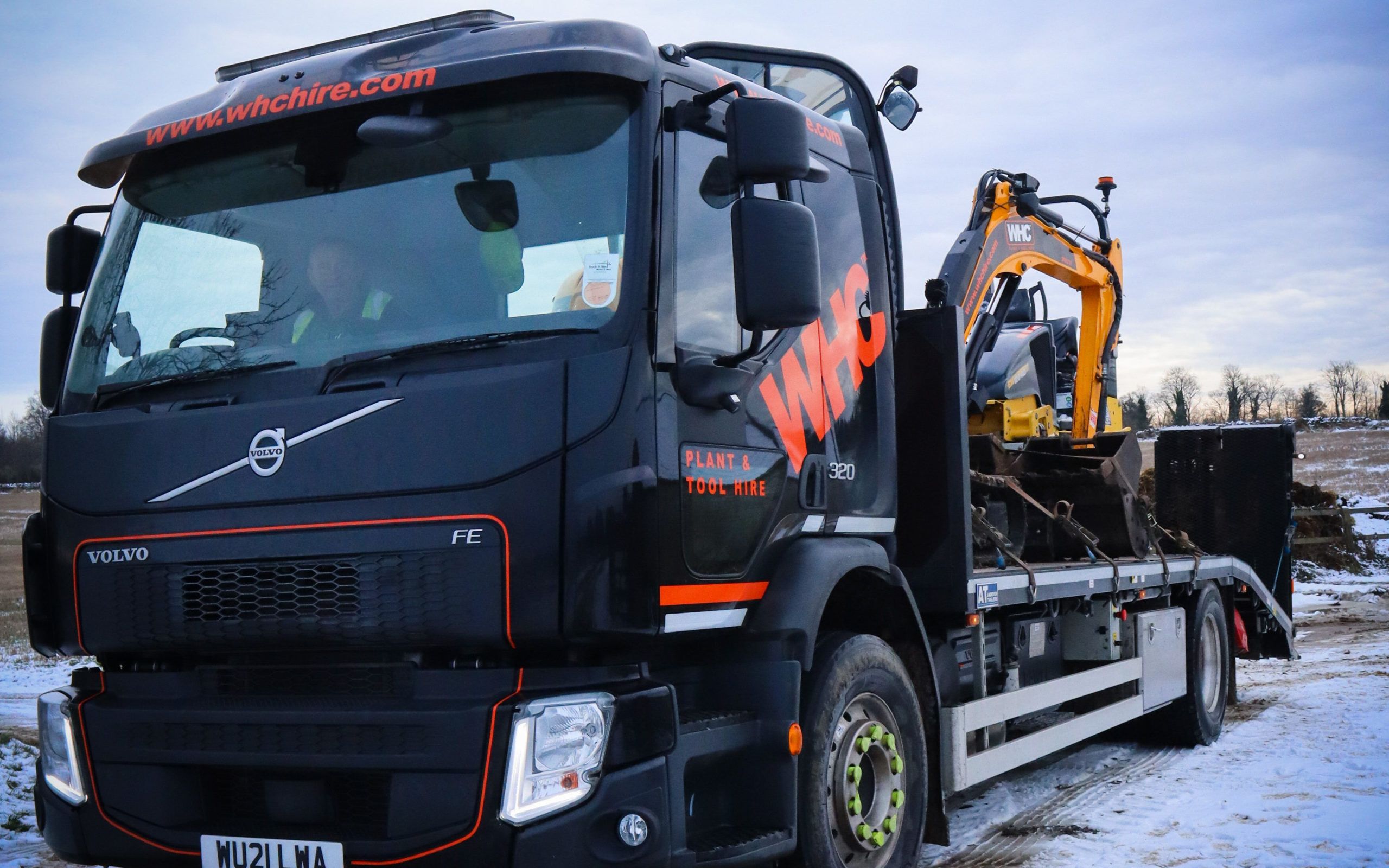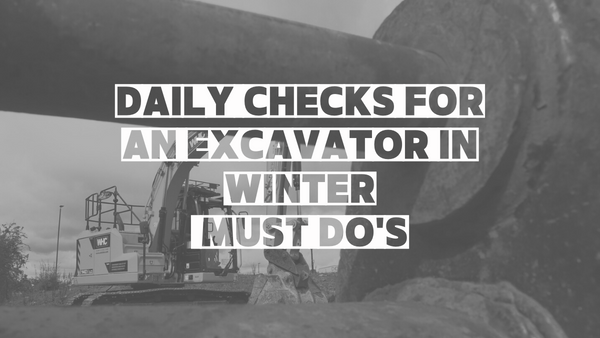Checks for an Excavator in Winter- Must DO’S!
Excavators are popular earthmoving machines, designed to operate anywhere during all conditions. They are crucial pieces of construction equipment that are used to complete tasks such as digging, trenching, lifting, landscaping and demolition. Most excavators will see around 10,000 hours worth of work during their lifespan. Depending on the make, model, and how well they are maintained, will determine what state the state of the equipment after this time. Operating a digger in winter can be one of the most difficult times to do so. Therefore, when working through the elements, sub-zero temperatures or never-ending downpours, it is important that your equipment is working correctly. You can reduce the risk of accidents caused by machinery by going through a set of pre-operational checks. In today’s article, we will take you through specially designed, preoperational checks for an excavator in winter.
What are the additional hazards in Winter? (UK)
We can all agree, winter in the UK can be harsh at times, making working outside in the elements more difficult than at other times of the year. This only enforces the necessity of completing pre-operational checks for an excavator in winter. The usual risks of operating an excavator apply, however, there are some additional ones such as:
Lighting
During the winter months, there is a lack of daylight hours to operate safely within. Therefore, you need to make sure that there is an adequate amount of lighting available to operate an excavator safely. This is to make sure you can avoid hazards on the ground while moving or using the machine. If there is inadequate lighting in the workplace you must rectify it before work commences. Checking all excavator lighting is working correctly or adding additional lighting if required, are the most common ways to control this risk. Other options, such as lighting towers can be useful for eliminating larger dark areas if necessary.
Ice, Snow & Frost
Just what winter is most famous for. Throughout the whole of the winter period, you will no doubt encounter more than one of these risks daily. Make sure that any ice and snow that has settled overnight is removed from the machine, as this can interfere with the boom and dipper arms. Clear any snow that may have come to rest on the steps into the excavator to ensure safe exit and entry of the machine. Then finally, remove any ice from the windows of the cabin, to make sure that operators have clear windows with no obstructions before using. Ice, snow and frost can be avoided if your machine is kept indoors. However, this is not always practical, especially when on a construction site.

Daily checks for an excavator in Winter. Step by step.
Now we are going to look at some daily checks of an excavator in winter that you should complete before using it. Start by:
Clearing all snow or ice from the excavator
This can be done by brushing the snow off the machine, paying attention to the boom, dipper arm, cabin roof, doorsteps or tracks. It is crucial to remove all snow and ice from the excavator as when it becomes compact, it can damage the excavator boom and canopy.
Pins on boom dipper and hitch.
Once you have cleared all the snow from the machine, you can clearly see if the boom, dipper and hitch pins are all in place. This is essential to check to make sure the boom can move and stay connected. Check for any damage or excessive wear and tear.
Check for hydraulic leaks on rams and hoses
Make sure that your hydraulic rams and hoses are intact and are not corroded by the extreme cold weather. Repeated exposure to ice and snow will corrode hydraulic rams. If they are not required then they can be removed until needed at a later date. Regular steam washes of the excavator exterior will help prevent a build-up of salt and rust.
Check the cab is structurally sound and all glass and door is present
Visually check the structure of the cabin looking for any cracks, broken seals or damage to the excavator. This also includes the roof after removing any potential snow. Finally, check that the door handle works and can be operated safely.
Visually check the bodywork for damaged or loose panels
Check the bodywork of the excavator that it is intact and is all present. Make sure that there is no ice or snow obstructing the exhaust. It is important to check all bodywork for any damage that could have occurred since using the machine last. If the excavator is not safe to use then organise a replacement.
Check tracks for damage
During your visual checks, you need to make sure that you pay attention to the condition of the excavator’s tracks. Whilst working in poor weather conditions, it is essential that you have and continue to have traction. Check that your excavator tracks are present and in good condition. Do not use the machine if its tracks are unsatisfactory. This will only lead to accidents happening.
Check the hydraulic oil level
Before turning the machine on, you need to make sure that the machine has enough hydraulic fluid to operate throughout the whole day. Hydraulic fluid level meters can be found in all different areas of the excavator. If you are not too sure then always ask an expert or refer to the user’s manual. Hydraulic fluid should be indicated in the centre of the measuring dial when the boom is placed in the service position.
Check oil and engine water level
Next, check the engine oil and water level which you will find with the engine. Remove the oil dipstick and wipe, return and then measure the oil level by removing the stick again. Check that the water levels are correct and are in between the marks supplied on the excavator.
Check seat belt is present and works correctly
When you enter the cabin, make sure you use three points of contact to help you inside the excavator and the same when you leave. Sit inside the excavator and check that the seatbelt works correctly and is still present.
Check the horn is working correctly
Make sure that the horn is audible. This can be used to attract the attention of operators and grounds staff whilst in operation.
Check the kingpin
Check the Kingpin attachment which is between the boom and the cab holding the two excavator components (boom & machine) together. Be sure to check for cracks or excess damage since the machine was last operated. If there appears to be any damage then do not operate the excavator.
Check all buckets are intact and not damaged
Check for any cracks or damage caused to the digging, ditching and grading buckets since last use. Ensure that they are cleared of any fallen snow or debris and are correctly hitched to the machine.
Complete the daily greasing procedure
Ensure that a full daily greasing procedure is completed for the machine is used. This begins with all the grease nipples from the front to the rear of the machine. This can be done with a leaver, air-powered or battery-powered grease gun. You can refer to your user manual to identify components that will require daily greasing.
Warm-up procedure
Start the machine and leave on tick over for a minimum of five minutes. This will allow the machine and its hydraulic system, enough time to warm up sufficiently. In extreme cold (below 0 degrees), it is best advised to leave the machine as long as possible. Once the machine is warmed up, start moving the excavator slowly. Not until the digger’s temperature gauges reach normal levels, can you operate the excavator at full power.
Check hitch is working correctly (auto or manual)
If you are using a manual hitch you can check that your bucket is secured to your boom by lifting it gently off the floor with your machine. Hold the right-hand control lever to the right until the excavator retracts and un-cradles the bucket. Once it reaches full extension, make sure you give the bucket a small rock to ensure it is connected properly. If it is connected properly, cradle the bucket and prepare to begin work. If the bucket is unsuccessfully connected, place the bucket back down on the floor and reconnect. Take your time and when performing this procedure be aware of other operators and groundsmen working in the vicinity.
Example of daily checks on a mini digger
Plant hire specialists in the Cotswolds
Here at WHC Hire, we have been supplying the nation with the highest quality plant machinery on the market since 1997. We offer a range of excavators from Mirco up to 28 tons, available to hire for short and long-term projects. With consistent investment into the quality of our fleet, we can assure that customers, contractors and businesses (no matter their size) receive their required equipment on time and in perfect working condition. We make it our mission to bring you the best available plant and tool hire equipment on the market. Allowing you to get the job done.
All of the checks for an excavator in winter shared in this resource, are conducted prior to any of WHC’s machinery arriving. With depots in the Cotswolds, Tewkesbury, and Worcester, we are able to service the whole country no matter the location of your project.
Click here to see the latest plant and machinery we have on offer, or call 01684377977 to discuss your project with one of our friendly and knowledgeable team.

